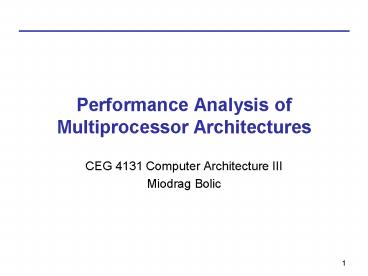Performance Analysis of Multiprocessor Architectures PowerPoint PPT Presentation
Title: Performance Analysis of Multiprocessor Architectures
1
Performance Analysis of Multiprocessor
Architectures
- CEG 4131 Computer Architecture III
- Miodrag Bolic
2
Plan for today
- Speedup
- Efficiency
- Scalability
- Parallelism profile in programs
- Benchmarks
3
Terminology
What is this?
4
Speedup
- Speedup is the ratio of the execution time of the
best possible serial algorithm on a single
processor T(1) to the parallel execution time of
the chosen algorithm on n-processor parallel
system T(n) - S(n) T(1)/T(n)
- Speedup measure the absolute merits of parallel
algorithms with respect to the optimal
sequential version.
5
Amdahls Law 2
- ? pure sequential mode
- 1 - ? a probability that the system operates in
a fully parallel mode using n processors.
?
S T(1)/T(n)
T(1)(1- ? )
T(n) T(1)?
n
1
n
S
(1- ? )
?
?n (1- ? )
n
6
Efficiency
- The system efficiency for an n-processor system
- Efficiency is a measure of the speedup achieved
per processor.
7
Communication overhead 1
- tc is the communication overhead
- Speedup
- Efficiency
n
S
?n (1- ? )ntc/T(1)
8
Parallelism Profile in Programs 2
- Degree of Parallelism For each time period, the
number of processors used to execute a program is
defined as the degree of parallelism (DOP). - The plot of the DOP as a function of time is
called the parallelism profile of a given
program. - Fluctuation of the profile during an observation
period depends on the algorithmic structure,
program optimization, resource utilization, and
run-time conditions of a computer system.
9
Average Parallelism 2
- The average parallelism A is computed by
- where
- m is the maximum parallelism in a profile
- ti is the total amount of time that DOP i
10
Example 2
- The parallelism profile of an example
divide-and-conquer algorithm increases from 1 to
its peak value m 8 and then decreases to 0
during the observation period (tl, t2). - A (1 ? 5 2 ? 3 3 ? 4 4 ? 6 5 ? 2 6 ?
2 8 ? 3)/ - /(5 3 4 6 2 2 3)93/25 3.72.
11
Scalability of Parallel Algorithms 1
- Scalability analysis determines whether parallel
processing of a given problem can offer the
desired improvement in performance. - Parallel system is scalable if its efficiency can
be kept fixed as the number of processors is
increased assuming that the problem size is also
increased. - Example Adding m numbers using n processors.
Communication and computation take one unit time. - Steps
- Each processor adds m/n numbers
- The processors combine their sums
12
Scalability Example 1
- Efficiency for different values of m and n
n m 2 4 8 16 32
64 0.94 0.8 0.57 0.33 0.167
128 0.97 0.888 0.73 0.5 0.285
256 0.985 0.94 0.84 0.67 0.444
512 0.99 0.97 0.91 0.8 0.062
1024 0.995 0.985 0.995 0.89 0.76
13
Benchmarks 4
- A benchmark is "a standard of measurement or
evaluation" (Websters II Dictionary). - Running the same computer benchmark on multiple
computers allows a comparison to be made. - A computer benchmark is typically a computer
program that performs a strictly defined set of
operations - a workload - Returns some form of result - a metric -
describing how the tested computer performed.
14
Benchmarks
- Challenges in developing benchmarks
- Testing a whole system CPU, cache, main memory,
compilers - Selecting a suitable sets of applications
- How to make portable benchmarks
- (ANSI C How big is a long? How big is a
pointer? Does this platform implement calloc? Is
it little endian or big endian? ) - Fixed workload benchmarks - how fast was the
workload completed - EEMBC MPEG-x benchmark time to process the
entire video - Throughput benchmarks -how many workload units
per unit time were completed. - EEMBC MPEG-x benchmark number of frames
processed for the fixed amount of time - Some benchmarks
- Dhrystone
- SPEC
- EEMBC
15
The Dhrystone Results
- This is a CPU-intensive benchmark consisting of a
mix of about 100 high-level language instructions
and data types found in system programming
applications where floating-point operations are
not used. - The Dhrystone statements are balanced with
respect to statement type, data type, and
locality of reference, with no operating system
calls and making no use of library functions or
subroutines. - Dhrystone MIPS (sometimes just called DMIPS).
- The program fits in a cache memory so that it
cannot be used for testing caches
16
EEMBC 3
- The Embedded Microprocessor Benchmark
Consortiums (www.eembc.org) - Benchmarks
- telecommunications,
- networking,
- digital media,
- Java,
- automotive/industrial,
- consumer,
- office equipment products
- Out-of-the-box portable code
- Cannot take advantage of a multiprocessing or
multithreading systems resources - Optimized implementations
- take advantage of hardware accelerators or
coprocessors or special instructions
17
SPEC 4
- The Standard Performance Evaluation Corporation
- www.spec.org/.
- SPEC CPU2000 focuses on compute intensive
performance, and emphasize the performance of - the computer's processor,
- the memory architecture,
- the compilers.
- CINT2000 integer programs
- CFP2000 floating point programs
18
SPEC
- Features
- Benchmark programs are developed from actual
end-user applications as opposed to being
synthetic benchmarks (like gcc). - Multiple vendors use the suite and support it.
- SPEC CPU2000 is highly portable.
- The base metrics
- same compiler flags must be used in the same
order for all benchmarks.. - The peak metrics
- different compiler options may be used on each
benchmark.
19
References
- Advanced Computer Architecture and Parallel
Processing, by Hesham El-Rewini and Mostafa
Abd-El-Barr, John Wiley and Sons, 2005. - Advanced Computer Architecture Parallelism,
Scalability, Programmability, by K. Hwang,
McGraw-Hill 1993. - The Embedded Microprocessor Benchmark
Consortiums (www.eembc.org) - The Standard Performance Evaluation Corporation
- www.spec.org/.

